When you regularly experience different games and stories, becoming somewhat set in your ways is unavoidable. You know what you like, you know what you don’t; and if you’re like me you sometimes actively push back against the memetic spread of hype when something out of your usual tastes starts catching on. That may read as contrarian, but the root of that avoidance comes more from wanting to enjoy something on my own time rather than dropping everything to ride a wave of popularity.
Such was the case with Doki Doki Literature Club, a game which became increasingly known (and in some ways renowned) after its 2017 debut for reasons we’ll get to shortly. Much of that growth seemed to come from viral exposure and the rapid growth of a fandom – the very roadblocks that make me want to hold off on a game until the fervor dies down.
Now here we are with Doki Doki Literature Club Plus!, an updated and expanded look into this charming slice of high school life. Coming out the other side, I’m both glad to say I avoided learning more than the absolute minimum until I was ready, and sorry to say it took me so long.
Some things to know before you join
Before moving any further, there are a few warnings to address. First, Doki Doki Literature Club is a game that should not be spoiled if you can help it. If you know next to nothing about the game, I highly suggest downloading the completely free PC version for the core experience. If you like what you see, want more of it, or enjoy the idea of sharing it with someone easily then Plus on Switch will be ready and waiting for you.
Reading any further past this point will go into spoiling and discussing the game’s actual content. Consider this cute screenshot the final barrier.
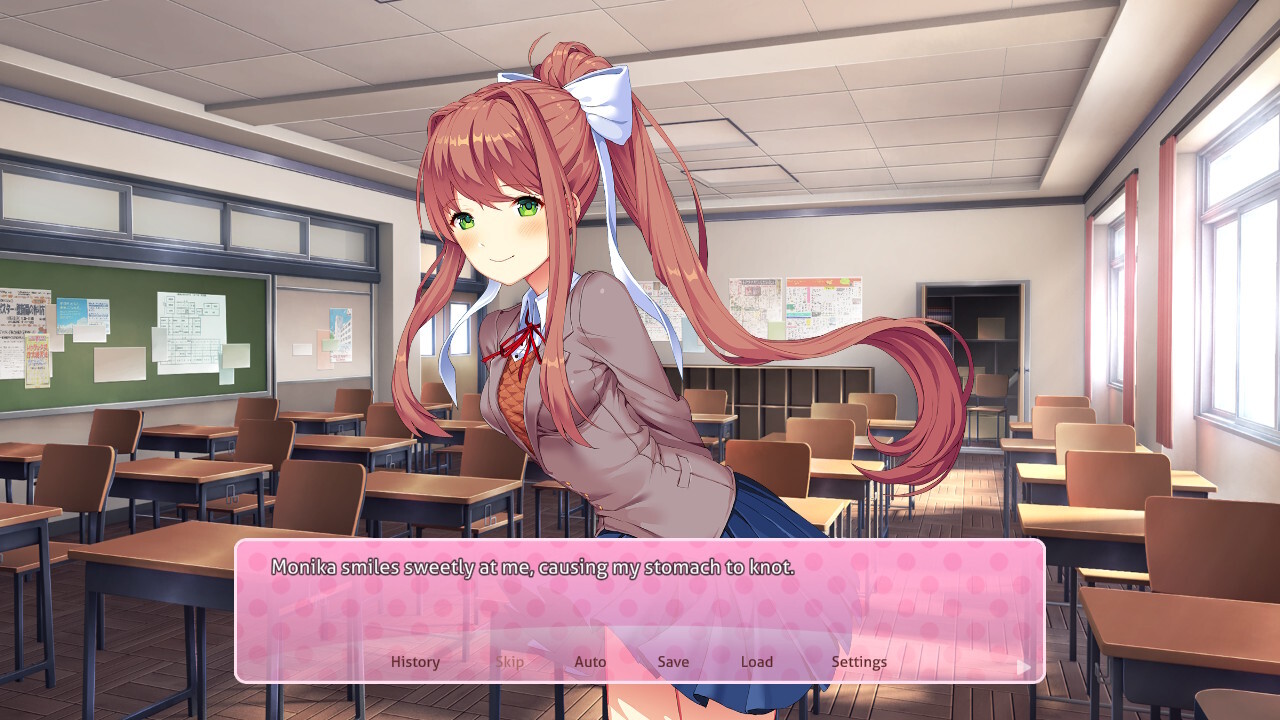
The other warning is that DDLC deals with (and openly warns you as a player of) some serious and potentially uncomfortable themes. Depression, anxiety, abuse, self-harm, suicide, and a lack of self worth are all brought to the forefront in this by all early appearnances sugar coated visual novel. There are ways to toggle on indicators for these depictions as you play. This review will be addressing some of these themes as well within the context of their place in the game.
Time to share our poems
With that out of the way, it’s time to join the Literature Club! The first half hour or so with DDLC introduces you to the club’s four members: your bubbly-yet-flighty childhood friend Sayori, the smol and abrasive Natsuki, quiet but obsessive Yuri, and the club’s president Monika. The game’s namable, playable character only attends due to Sayori’s insistence, but soon he’s driven by the potential to romance any one of these cuties.
You do so by “writing poems” and occasionally making dialogue choices. The poems are less that and more picking from words you think your intended best girl will appreciate. These match up with their interests and personalities, and pursuing your favorite isn’t too tough if you pay attention. Impressing a girl will let you spend more time with them, though with hints that some of the others are catching on to your intent. It’s subtle at first, but between that, other conversations, and the girls’ own (fully written) poems you begin to get a fuller understanding of them all.
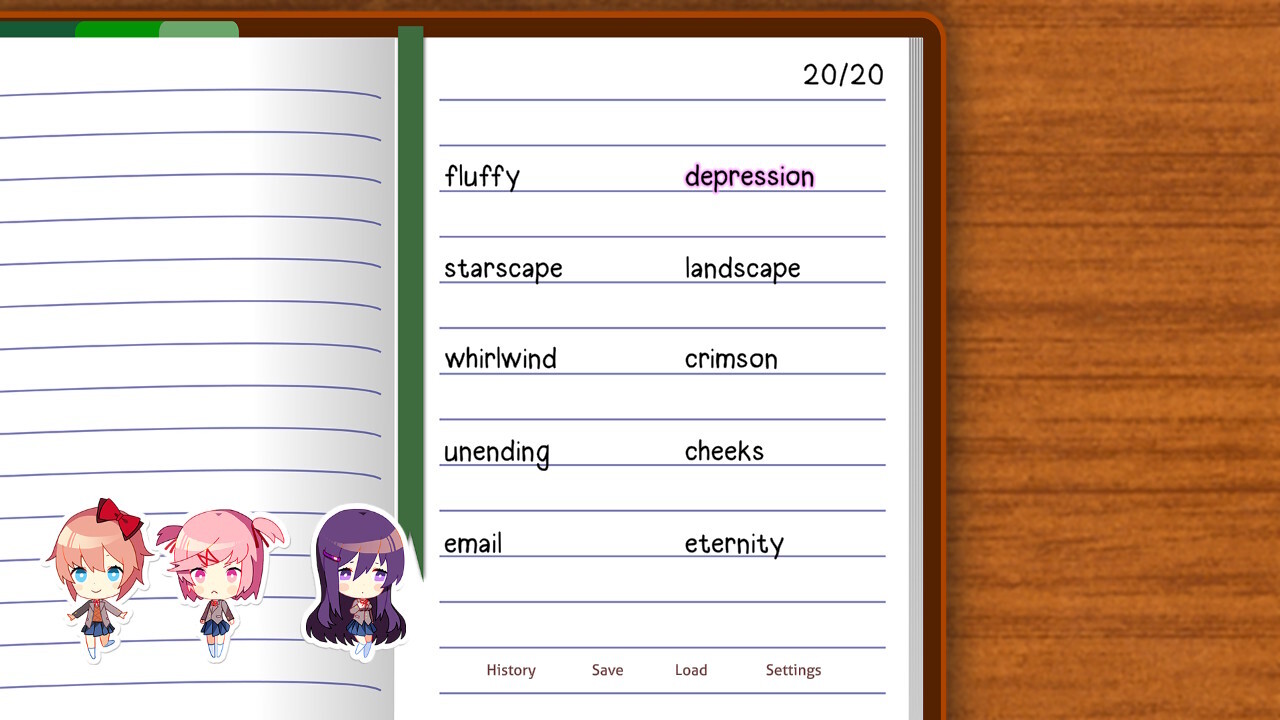
This culminates in the revelation that one of the four is suffering from severe depression. While I knew the story was building towards something, this still caught me off guard. It’s rare for a game to approach the subject with nuance and sincerity, with the character expressing her feelings both in how they impact her daily life and her relationships.
Suddenly certain bits of character, otherwise adhering to typical anime tropes, are revealed to be real symptoms. It’s only a short few sequences where her depression is at the forefront, but they manage to make an impact and set things up for an even bigger swerve. This all could have easily been treated poorly, but it works and I commend the game’s writer their effort to take the matter seriously within the narrative. The core of Doki Doki Literature Club’s first act elicited real empathy from me as a player, something I appreciated and wasn’t fully prepared for.
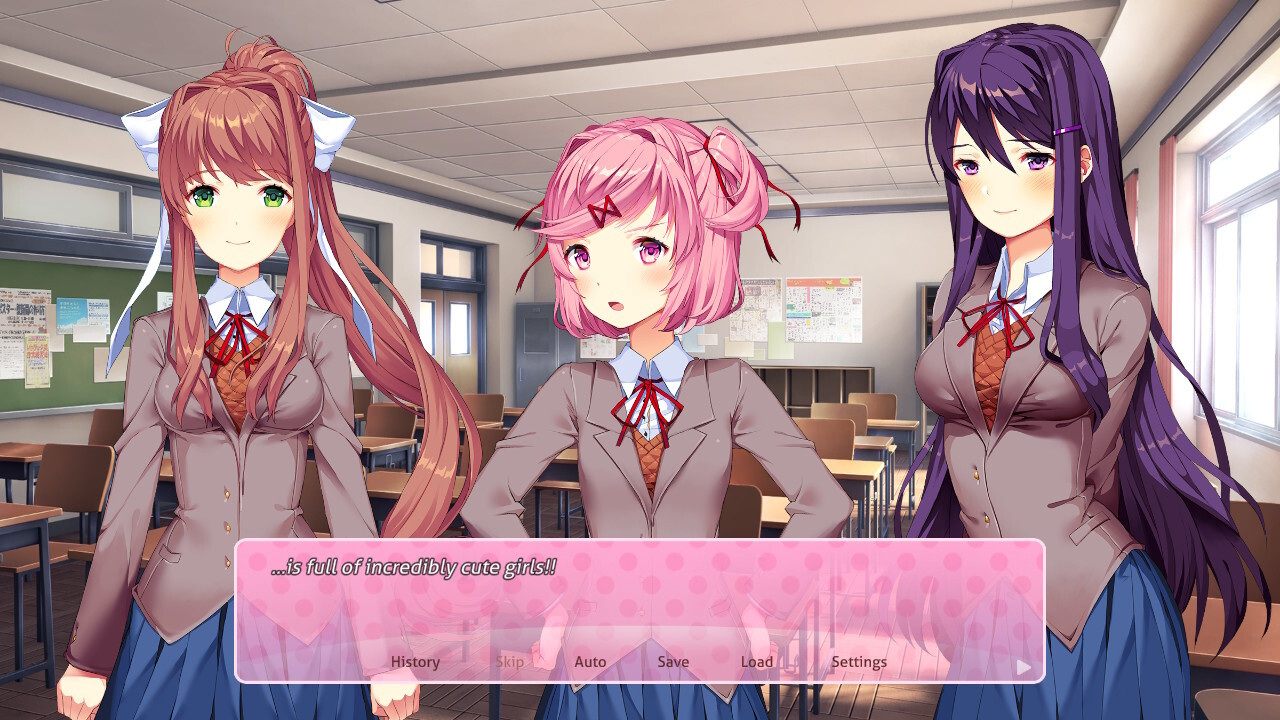
That was worth the more cookie cutter VN conventions that stain these pages. The other pursuable partners contrast with each other, but still fit typical molds of the genre. Their own secrets, struggles, and insecurities come forth later on and in side content (though not without foreshadowing) but never hit the same resonant peak. It’s in their personal stories that topics like anxiety and self worth are explored. I’ll admit trying to address its whole cast while still telling a mostly singular story would have likely crowded things, but I couldn’t help but want more.
Those minor criticisms are secondary to the following, though. The player character’s perspective and attitudes were bland and play into the railroaded mindset of needing to “win” one of these girls. Disliking him is the intent (per the game’s creator Dan Salvato) but watching his approach to talking with the other characters and even his attempts to help once he’s made aware of the fuller situation is frustrating to sit through. That lack of tact does give way to the game’s most shocking swerve of all though, one that fundamentally changes its very nature.
Now everyone can be happy
Due to this sudden shift, you begin to play through the game again but without one of the four girls present. Not missing, not ignored – deleted entirely from its narrative. As such you gain more perspective on their impact on the club’s dynamic as a group of friends, which was an interesting approach. It’s very It’s a Wonderful Life in how it shows how the rest would be without their presence, and is relatable for anyone who’s wondered exactly how they fit into any social dynamic. This wasn’t the main focus of the second act, but it was a subject I found particularly interesting.
It’s during this portion that Doki Doki Literature Club embraces both psychological horror and full meta-awareness of itself. For reasons that are made clear as you go, some of those personality traits you might’ve found cute before are dialed up. They become twisted and manipulated versions of the selves you knew, and seeing those differences pile on kept me engaged. Well, that and the sudden frequency of visual glitches, overwritten text, and the understanding that something or someone is making these things happen.
On PC you could actually explore the game’s files both to find secrets and potentially have an effect on the story, which is replicated on Switch via an in-game browser. It gets the job done, preserving one of DDLC’s most unique elements while also serving as a hub menu for the Plus exclusive extras.

While I felt the game was onto one thing with its initial (and I’d say earnest) hard left turn into discussing mental and social conditions, it goes on to mostly abandon that in the name of being “creepy”. Self harm becomes a recurring subject during these portions, but is used in a different and much more horrifying way. Put another way, Doki Doki Literature Club spent its first half tugging at my heart, only to pivot to trying to play with my mind. Surprise glitches and recognition of its own medium may be entertaining and unsettling, but for me the earlier tonal shift was more compelling and had potential all its own.
That’s not to say that happenings from the game’s second act on aren’t their own kind of morbid entertainment. The changes to the characters and presentation may not have resonated the same way but they led me down a rabbit hole of easter eggs and surprises. DDLC wouldn’t be itself if it didn’t interweave these two aspects, and even when it didn’t hit as hard I still ended up playing through (fast forwarding dialog I’d already seen) multiple times to delve further into its encoded world.
For the record, horror isn’t a genre I delve into much. That (and the strength with which they’re handled) may be part of why the emotional and character focused aspects centered on the Literature Club made a bigger impact on me. I did make the mistake of playing through some of the bleakest and most deranged moments in the dark, and actively lost sleep over this game because of it. Anything that manages to make its way under your skin like that has done something right.
I’d be remiss not to mention the finale specifically, though, which managed to leave a strong impression in all respects. Things build up in such a way that you lose any control over what’s happening, a sharp contrast from its genre inspiration that heightens its attempts at mind bending. It took me from the longest weekend of any video game I’ve ever played to a medium shattering finale that changes what Doki Doki Literature Club “is” for a third or fourth time. What it never stops being, though, is interesting. A blend of unapologetic and bittersweet were the lasting flavors, and even if I didn’t savor every moment that brought me to the end it was a refreshingly unique break from reality.
My Song, Your Note
Revisiting Doki Doki Literature Club multiple times had other benefits aside from seeing new surprises and subtle twists on the story as I first experienced it. You’ll fill out a gallery as you play, some of which are locked behind things like selecting certain words for poems or exploring the game’s files. Even after at least four playthroughs and every side story I’m still missing some things, so anyone with a completionist mindset for these sorts of extras will have some added incentive to replay. These included all the girls’ poems in one convenient place, as well as concept art and other assets. The game’s soundtrack can also be revisited (and made into a custom playlist) from its own dedicated menu.
By getting to know each girl you’ll unlock brand new side stories that are in their own separate section of the game’s browser. Serving as something of a prequel, I suggest playing through them in the order they’re organized in their menu. Going through all of them will teach you about the founding of the Literature Club and how these four contrasting personalities became friends.
As I’ve already mentioned, I was more drawn to and impressed by these characters’ personal and social struggles and how they’re not shied away from. That’s what these side stories focus on, and I should have been careful what I wished for. Not because I miss the blatant horror elements, which are absent from these (along with the playable character), but because my heart can only take so many feelings at once. Yet I couldn’t stop myself from going through each of these vignettes in one sitting.
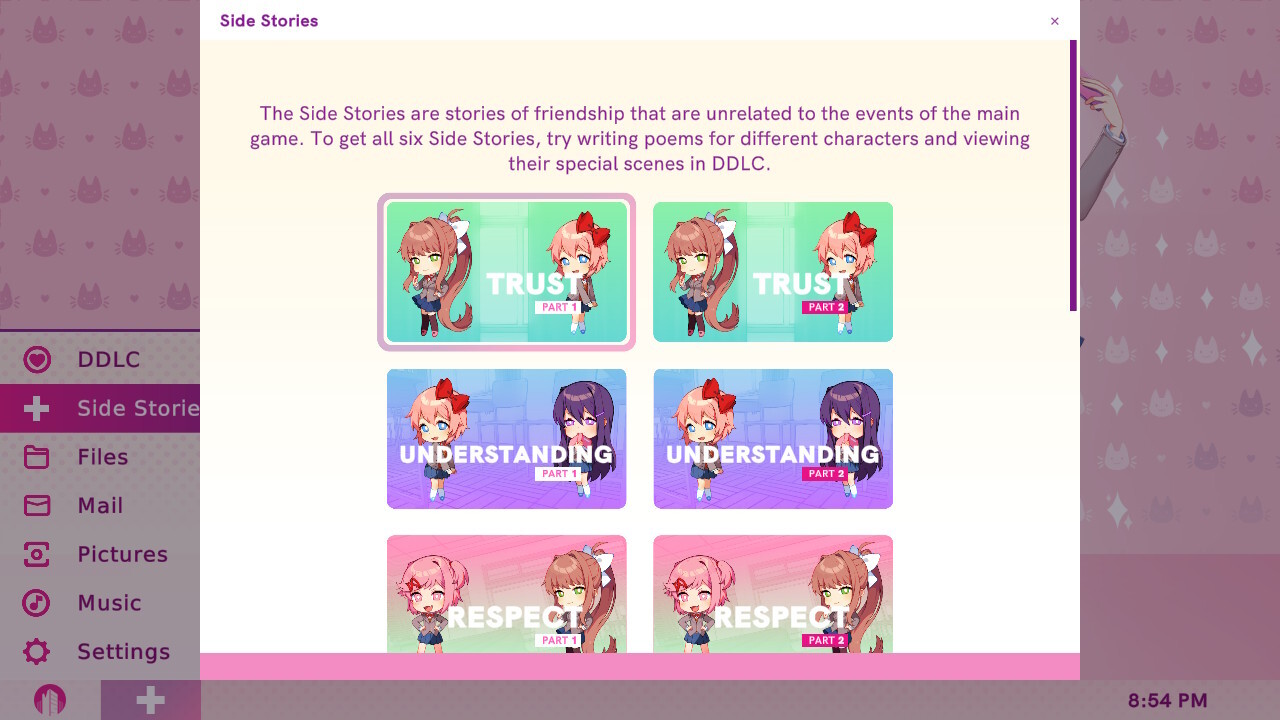
The side stories have you witnessing not just the Club’s beginning, but show how and why each of the four girls came to it in the first place. Their dynamics with each other are explored, pairing up the girls in ways that weren’t seen in the base game. If you ever wondered how Monika and Natsuki get along or what Sayori’s cheerful exterior does to Yuri’s more withdrawn personality, this is where you’ll find it. It’s a mix of tender and heartrending moments with the same care for its cast and those who relate to them.
These episodes reinforce what I’d call Doki Doki Literature Club’s main theme – communication. There’s the obvious, like the focus on poetry and self expression through it, as well as vulnerability that comes with sharing yourself with others. Even the manipulations and frightening elements are the game communicating with you the player, something doubled down on in its ending. That realization of just how important communication is both within this game and life in general is something I never would have expected going in. Maybe it won’t be able to write its way into everyone’s heart in that way, but I encourage you to not wait like I did originally and to give it a chance.
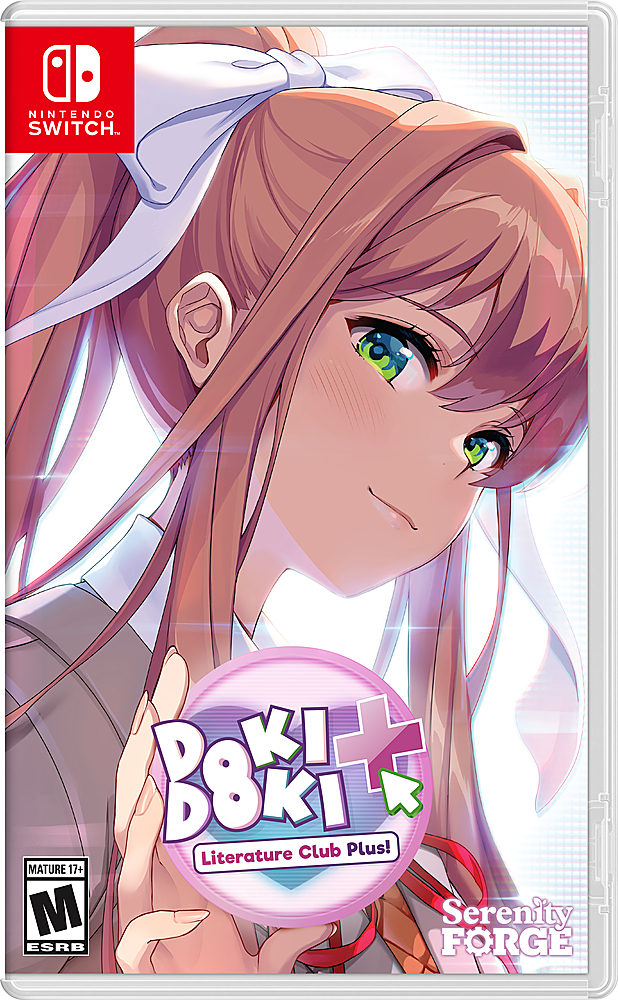
System: Nintendo Switch
Release Date: June 30, 2021
Categories: Visual Novel, Horror
Publisher: Serenity Forge
Developer: Team Salvato


